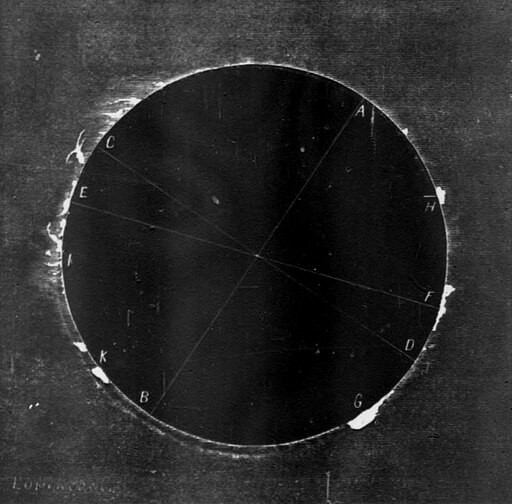Eclipses have fascinated humans since the earliest days of recorded history. These rare cosmic events have helped us understand the Earth and other members of the Solar System. Despite the advancements in modern technology, however, there are still instances when our observations of solar eclipses have led us to astronomical mistakes.

(Photo: Wikimedia Commons/ American Ephemeris and Nautical Almanac)
Pursuit for New Cosmic Discovery
In July 1869, astronomers were making frantic preparations for a coming total solar eclipse that would be visible in the U.S. Experts planned scientific expeditions to travel into the path of totality to observe the Sun and the rare sight of its outer atmosphere.
Just a few months earlier, experts studying another eclipse in India discovered a new chemical element inside the Sun. The element was more readily observed during the event, so astronomers had a good reason to investigate what was lurking behind the Moon's shadow.
During the 19th century, scientific discoveries were made at breakneck speeds. These discoveries were sometimes monumental, and experts did not have the background knowledge to make sense of what they witnessed. Among these advances is the discovery of the Sun's spectrum, which included lines that overlay the band of colors that make up sunlight. Such lines discovered by German physicist Joseph von Fraunhofer can reveal the presence of elements inside our host star.
In October 1868, astronomers Pierre Jules César Janssen and Joseph Norman Lockyer measured the spectrum of the Sun during a total solar eclipse. They found evidence of a new line in the yellow part of sunlight, which did not correspond to any known element. When viewed from the smog-laden city of London, Lockyer assumed the line was a metal. He named it Helium after Helios, the Greek god of the Sun.
With the discovery of helium, scientists realized that eclipses could lead to new discoveries. Astronomers in the U.S. were keen to observe the total solar eclipse of August 7, 1869, which swept North America from southern Alaska down through North Carolina.
Professor Charles Augustinus Young from Dartmouth College and U.S. Navy Lieutenant Commander William Harkness traveled to Iowa to observe the Sun's ghostly crown of flame. Young and Harkness saw a new barcode line in the solar spectrum using their telescopes, but it was bright green instead of yellow.
READ ALSO: What To Expect During a Solar Eclipse? 10 Unusual Phenomena to Look Out for This Weekend
A New Element That Never Came to Be
Harkness hypothesized that the green line revealed a new element, which was later dubbed coronium. 1902 Dimitri Mendeleev, the Father of the Modern Periodic Table of Elements, renamed Newtonium. For decades, scientists have struggled to understand this element.
Proving the existence of a new element would require replication in a laboratory, yet no one can independently confirm coronium. In the 1930s, Swedish astronomer Bengt Edlen suggested that coronium may not be a new element after all. Instead, it was a form of iron transformed due to immensely high temperatures.
It was proposed that the transformation caused 13 of iron's 26 electrons to get cooked off at temperatures so high they seemed impossible. Transforming iron this way would require temperatures more than 1.8 million degrees Fahrenheit (almost 1 million degrees Celsius), which is unspeakably hot, even far hotter than the surface of the Sun.
Edlen's theory did not make much sense, and it still does not. For almost a century, astronomers have tried to understand how the Sun's atmosphere could reach these temperatures. As of now, the existence of coronium remains one of the biggest questions in physics.
RELATED ARTICLE: Two Chromospherically Active Variable Stars Detected in Highly Eccentric, Eclipsing Binary System
Check out more news and information on Eclipse in Science Times.














